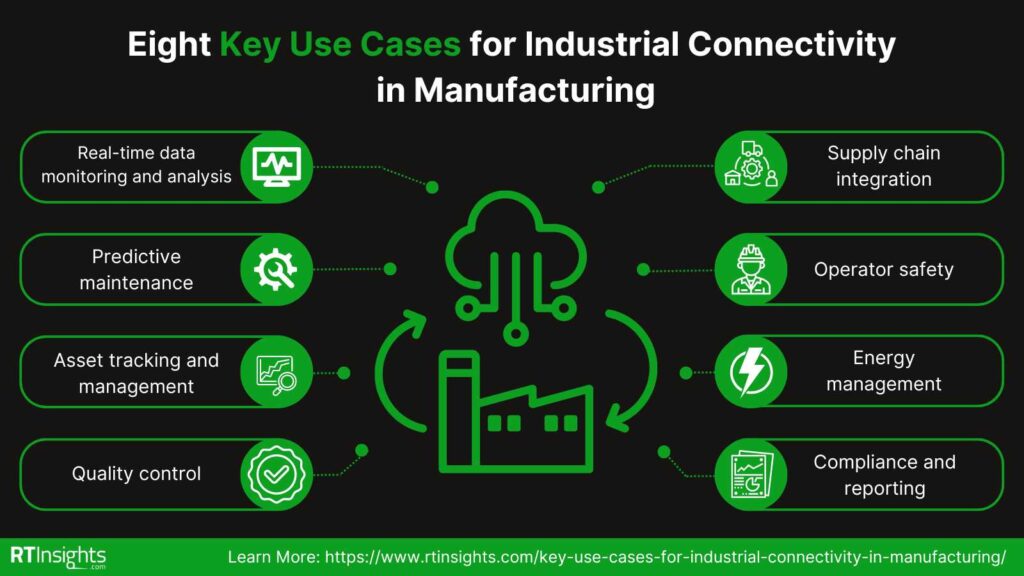
While many have talked about the possibilities and potential of things like smart factories and Industry 4.0 for years, the realization of many benefits of those loftier visions and strategies is achievable today by leveraging industrial connectivity.
Industrial connectivity in manufacturing enables a wide array of applications to improve efficiency, enhance production quality, enable real-time monitoring and control, and facilitate smart decision-making processes.
While many have talked about the possibilities and potential of things like smart factories and Industry 4.0 for years, the realization of many benefits of those loftier visions and strategies is achievable today by leveraging industrial connectivity to break down silos typically found in manufacturing.
In fact, several commonly employed use cases enabled by providing standardized access to data via industrial connectivity have delivered a significant impact across manufacturing operations around the world. Some of these key use cases that are possible include:
Real-time data monitoring and analysis: Manufacturers routinely use industrial connectivity to monitor equipment and production processes in real time, allowing for immediate adjustments to improve efficiency, reduce waste, and prevent downtime.
Predictive maintenance: By analyzing data from sensors and machines gathered via connectivity solutions throughout a facility, predictive maintenance systems can forecast when equipment might fail or require maintenance, preventing unexpected breakdowns and extending the lifespan of machinery.
Asset tracking and management: Industrial connectivity allows for the tracking of physical assets throughout the manufacturing process, improving inventory management, reducing loss, and optimizing the supply chain.
Quality control: Automated systems and sensors can continuously monitor product quality, identifying defects or deviations from standards in real-time, thus ensuring higher quality outputs.
Energy management: Connectivity enables the monitoring and management of energy use across manufacturing operations, helping to identify inefficiencies and opportunities for energy savings.
Supply chain integration: Seamless data exchange between suppliers, manufacturers, and distributors enhances supply chain visibility, enables just-in-time inventory practices, and reduces lead times.
Operator safety: Wearable sensors and safety monitoring systems can ensure worker safety by detecting hazardous conditions, monitoring health indicators, and enforcing compliance with safety protocols.
Customization and flexibility: Advanced connectivity and data analytics allow manufacturers to adapt more easily to changes in consumer demand, enabling more flexible production lines and customization options.
Compliance and reporting: Automated data collection via industrial connectivity and analysis of that data simplify compliance with regulatory requirements and facilitate more accurate and timely reporting.
See also: The Evolution of Manufacturing in the IoT Era
Taking operations to the next level
These use cases represent the low-hanging fruit of what is possible when industrial connectivity is ubiquitous. The technology also allows more advanced, future-leaning applications that address more strategic (vs. operational) objectives.
For example, industrial connectivity is the cornerstone of smart factories and Industry 4.0. But leverage connectivity, big data, AI, and automation to create highly efficient, self-optimizing production environments.
Another area that is gaining interest is collaborative robotics environments. Robots connected to the manufacturing network can work alongside humans, learning and adapting to new tasks and improving efficiency and productivity.
And given the lessons learned during the pandemic, many organizations found that some aspects of their operations can be done remotely. To that end, industrial connectivity can help managers and technicians monitor and control production processes from remote locations, offering flexibility and the ability to respond quickly to issues.
Critical technologies to enable these use cases
Implementing industrial connectivity in manufacturing involves integrating a variety of technologies that work together to collect, transmit, analyze, and act upon data across the manufacturing process.
Some key technologies needed for manufacturers to leverage industrial connectivity effectively include:
Industrial Internet of Things (IIoT) devices and sensors: These elements enable the collection and sharing of data from machines, equipment, and environments. Sensors can monitor a wide range of parameters, including temperature, pressure, humidity, vibration, and more.
Edge computing: Edge computing processes data near the source of data generation (i.e., at a machine or system on a production line) rather than relying solely on centralized data centers. This reduces latency, conserves bandwidth, and enhances real-time data processing capabilities.
Cloud computing: Cloud platforms provide scalable resources for data storage, processing, and analytics, facilitating global access to manufacturing data and insights. They also support collaboration across different locations and departments.
Analytics and AI: Analytics tools and artificial intelligence (including machine learning algorithms) are used to analyze vast amounts of data generated by IIoT devices. These technologies can identify patterns, predict outcomes (such as equipment failure), and optimize processes.
Cybersecurity solutions: As connectivity increases, so does the risk of cyber threats. Cybersecurity solutions are critical to protect sensitive data and ensure the integrity and reliability of manufacturing systems.
Wireless communication networks: Wireless communication technologies, such as Wi-Fi, 5G, and Low Power Wide Area Networks (LPWAN), provide the backbone for transmitting data across devices and systems within the manufacturing environment.
Digital twins: Digital twins technology allows manufacturers to simulate, predict, and optimize the performance of products and processes before implementing them in the real world.
SCADA and MES systems: Supervisory Control and Data Acquisition (SCADA) systems and Manufacturing Execution Systems (MES) are critical for monitoring and controlling industrial processes and for ensuring the effective execution of manufacturing operations. Industrial connectivity can help bring data from these typically siloed systems into the fold for use in a broad range of applications.
Implementing these technologies requires careful planning, investment, and a strategic approach to digital transformation. It involves not just technological upgrades but also changes in organizational culture, processes, and workforce skills development.










